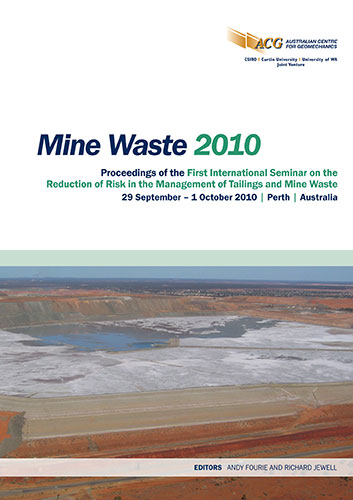Rockfill embankment construction on tailings — realistic, cost-effective and reliable application at Xstrata, Mount Isa, Australia

|
Authors: Reinke, G; Soliman, A; Purkis, A |
DOI https://doi.org/10.36487/ACG_rep/1008_34_Soliman
Cite As:
Reinke, G, Soliman, A & Purkis, A 2010, 'Rockfill embankment construction on tailings — realistic, cost-effective and reliable application at Xstrata, Mount Isa, Australia', in R Jewell & AB Fourie (eds), Mine Waste 2010: Proceedings of the First International Seminar on the Reduction of Risk in the Management of Tailings and Mine Waste, Australian Centre for Geomechanics, Perth, pp. 405-416, https://doi.org/10.36487/ACG_rep/1008_34_Soliman
Abstract:
Mount Isa Mines Ltd (MIM), Queensland, Australia, was formed in 1923 when a discovery of silver lead ore was made. At the beginning, the production was focused on lead-zinc-silver mined underground with little focus on copper. Currently, copper is mined in two underground mines and lead-zinc is mined in two open cuts and an underground mine. It was not until June 2003 that Xstrata officially took control of Mount Isa Mines Ltd. In general terms, the geology of the mining area is comprised mainly of Urquhart shale and Spear siltstone. The history of the Xstrata Mount Isa Mines tailings storage facility (TSF) stretches back to the 1930s with the construction of the No. 1 tailings facility. The current tailings storage facility has two existing and five decommissioned dams. The existing dams, Nos. 7 and 8 comprise five external walls with nine internal groynes covering an estimated area of 1,300 hectares. Current operational capacity, as of Q2 2009, was approximately 16 million cubic metres with more capacity identified in late 2009 with the utilisation of the western and southern evaporation ponds. The current tailings strategy is to continue depositing wet tailings via a gravity outfall line to two of the existing tailings dams, and to also raise dam walls and groynes as they become necessary. The existing strategy proved to be usable for 2–4 years by which time an alternative outfall should be established. Although a conventional geotechnical design was used to construct a groyne on the tailings of one of the tailings dams, recently the groyne has been constructed using the ‘ice-breaker’ technique utilising the waste rock available from the nearest open cut to the tailings area. The lesson learnt from the success of the construction trial of the groyne will be applied next year to the proposed high groyne on the tailings as part of the future tailings placement. By doing so, the life of the existing tailings dams will be extended by postponing the need for a pumped outfall, and hence reducing future operation costs. This is in addition to the benefit of consuming waste rock close to the source, resulting in reduced operating costs to the open pit. The paper presents various aspects of the project. These include a brief on the current and future tailings strategy, the proposed conventional geotechnical design and the economic and safe construction technique used instead to construct the groyne. A summary of the geotechnical modelling results are also presented. To demonstrate the financial benefit, the paper provides cost and time comparison between the conventional design, if adopted for construction, and the realistic and successful construction trial approach.
References:
Caldwell, J.A. (1985) Simplified Stability Analysis, in design of non-impounding mine waste dumps, M.K. McCarter
(ed), The American Institute of Mining, Metallurgical and Petroleum Engineers, pp. 48–54.
Golder (2009) Groyne 9 design report, Golder Associates Report, unpublished.
Rocscinece (2005) Phase2 6.0 User’s Manual, Rocscience Inc., Canada.
Soliman, A. (2008) MPV WRD TD5 – Tailings assessment, Internal report, Xstrata Zinc, Mt Isa, unpublished.
Soliman, A. (2010) Rockfill embankment on tailings numerical simulation, Internal memorandum, Xstrata Zinc, Mt Isa,
unpublished.
Youd, T.L., Idriss, I.M., Andurus, R.D., Arango, I., Castro, G., Christian, J.T., Dobry, R., Finn, W.D.L., Harder, L.F.,
Haymes, M.E., Ishihara, K., Koester, J.P., Liao, S.S.C., Marcusson, W.F., Martin, G.R., Mitchell, J.K.,
Moriwaki, Y., Power, M.C., Robertson, P.K., Seed, R.B. and Stokoe, K.H. (2001) Liquefaction Resistance of
Soils: Summary Report from the 1996 NCEER and 1998 NCEER/NSF Workshops on Evaluation of
Liquefaction Resistance of Soils, Journal of Geotechnical and Geo-environmental Engineering, ASCE, Vol. 127,
No. 10, pp. 817–833.
© Copyright 2025, Australian Centre for Geomechanics (ACG), The University of Western Australia. All rights reserved.
View copyright/legal information
Please direct any queries or error reports to repository-acg@uwa.edu.au
View copyright/legal information
Please direct any queries or error reports to repository-acg@uwa.edu.au